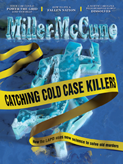The upper peninsula of Michigan is a sparsely populated place with its own sense of identity — something it has in common with Afghanistan. The young men at the center of the moving documentary Where Soldiers Come From — all proud UP natives — never discuss this duality, but it helps explain the perceptiveness and compassion they display when their National Guard unit is deployed to fight in America’s longest-running war.
When Dominic Fredianelli’s team finds weapons on an Afghan landowner’s property, and the man is taken away in handcuffs, Dom, a promising artist from Hancock, Michigan, population 4,600, feels more troubled than triumphant. The guy, he surmises, was in a no-win situation: If he didn’t do as the Taliban wanted, they’d probably kill his family. Dom can imagine making the same choice.
Dom’s best friend Cole Smith joined the Guard with him. Blessed with a comedian’s quick wit, he survives the insanity by savoring the irony of their situation, declaring at one point: “I miss the freedom we’re fighting for!” Their mutual friend Matt “Bodi” Beaudoin goes the opposite direction, insisting that his tour of duty has turned him into “a racist American.” But we don’t really believe it; actual racists aren’t that self-aware.
The Nov-Dec 2011
Miller-McCune
This article appears in our Nov-Dec 2011 issue under the title “The Boys Are Back.” To see a schedule of when more articles from this issue will appear on Miller-McCune.com, please visit the
Nov-Dec 2011 magazine page.

Where Soldiers Come From, airing on PBS on Nov. 10 (the eve of Veterans Day), isn’t a particularly political film. While it documents the physical and emotional toll suffered by its young fighters, it doesn’t make a case for or against our involvement in the nearly decade-old conflict. Rather, it’s a coming-of-age story, part American Graffiti (without the music) part The Hurt Locker (without the melodrama).
Director Heather Courtney grew up in Michigan’s far north, just across the river from the town that produced Smith, Beaudoin, and Fredianelli. She returned in 2005 with the desire to make a movie about the region and its inhabitants. When she read in the local paper that the area’s National Guard unit was conducting its monthly training session, she decided to check it out. It was there she met the group of friends whose stories she would tell.
Just out of high school, Fredianelli and his buddies drift into Guard service. While some are motivated by patriotism or a family history of military service, most sign up without giving it a lot of thought. One weekend a month, a $20,000 stipend for college — what’s not to like?
For a couple of years, everything proceeds according to plan. Then comes the tap on the shoulder: news that the men’s next nine months would be spent in rural Afghanistan.
[youtube]gWixLvfef0Y[/youtube]
The Guardsmen’s job is simple: They patrol the desolate countryside, searching for improvised explosive devices. More often than not, they don’t realize they have found one until they run over it in their armor-plated vehicle.
This is not only terrifying, it contains echoes of the absurd. As one of the men notes, the bombs they are searching for were planted to kill foreign soldiers, so their job is to neutralize weapons that wouldn’t exist if they and their fellow Americans weren’t there. (A Camus-like scenario, at best.) The thought makes the concept of heroism a bit ridiculous — the guys never speak in those terms. They just want to come back in one piece.
Which they do — sort of.
Courtney, who spent five months with the men in Afghanistan, follows them for another two years as they haltingly attempt to resume their lives. Two are diagnosed with traumatic brain injury, the result of concussions caused by multiple explosions; one suffers from post-traumatic stress disorder; another remains undiagnosed but is constantly agitated and has difficulty sleeping. For most, anger flares frequently and unpredictably.
Fredianelli is, arguably, the lucky one: His artistic ability gives him an outlet, and a local junior college art teacher encourages him. Soon, he’s spending days by himself (as he prefers) creating a giant mural that depicts his experience in the war. The mural is vivid, nuanced, haunting. And, for Fredianelli, cathartic.
The same can be said for the film, which, like Fredianelli’s mural, is full of telling details. When an officer preparing the men for war can’t pronounce Hamid Karzai, we understand the level of information the soldiers are receiving. A scene of soldiers drinking Benadryl as an intoxicant is a haunting comment on their creativity and their desperate need for anesthesia.
And although we’ve seen it before, the disconnect between the guys and those who stayed behind is still unsettling. When Fredianelli, after suffering a serious concussion, comes home on leave, an old school friend responds to his description of the bomb blast by exclaiming, “Cool!”
That unsettling moment is not far removed from the numbness most of us feel after 10 years of battlefield reports and weekly lists of dead soldiers’ names. Courtney’s documentary is a powerful antidote to this disengagement.
“It’s easy to forget these wars are going on if you’re not personally involved,” the director notes. “I hope my film will make people feel somewhat more connected with these guys who are over there fighting.” Not to mention those who have returned home from Afghanistan and Iraq, forever changed.
Sign up for the free Miller-McCune.com e-newsletter.
“Like” Miller-McCune on Facebook.
Follow Miller-McCune on Twitter.
Add Miller-McCune.com news to your site.




